So for the first draft of this post, as I described to Mike offline the other day, I had thought that I would lace some interesting information about the Museum's web site traffic with some witty commentary, even a few jokes. I get jokes. After torturing that draft for a while longer this afternoon, I'm just going to get to the point. So, if you were looking for some self-deprecating humor or hilarious observations about the state of the PR profession, too bad. Maybe another day.
I thought our eight or nine readers might enjoy this sampler of links gleaned from our Web site statistics:
Among the sites offering links to us with some significant traffic so far this month: a Wikipedia page on hairballs that links to our virtual exhibit; two different but related pages about the Lincoln assassination; a government site about pandemic flu planning; a 2005 Medgadget post about our Human Body Revealed exhibition; a tourist-focused site called Things to Do. To all those sites, and others, we appreciate the business.
If I find any other statistical goodies, I'll be sure to post those, too.
An unofficial blog about the National Museum of Health and Medicine (nee the Army Medical Museum) in Silver Spring, MD. Visit for news about the museum, new projects, musing on the history of medicine and neat pictures.
Saturday, March 22, 2008
Museum News Hopefully Worth Noting
A few news items from museums near and far:
- Baghdad's National Museum, a treasure trove of artifacts from the stone age and Babylon to the Assyrians and Islamic art, will not reopen when renovation of two of its galleries is completed in a few months, an official said. (AP)
- Field Museum exhibit shows that mythical creatures didn't just spring from imagination (Chicago Tribune)
A little Googling led to some other related links: Here is the Wikipedia page on the National Museum, and here is what appears to be a nonprofit group interested in helping the Iraqis. And here is the link to the Field's new exhibit.
Enjoy.
Friday, March 21, 2008
Wounded vets rebuilding their lives
Walking around Walter Reed, even when not directly involved in patient care, one sees a lot of people who are working to get their bodies and their lives reconstructed. Here's an article about one of them - "Wounded Vet Again Tackles Basic Training; Swimmer Among Those Trying Out For Paralympics," By Amy Shipley, Washington Post Staff Writer, Friday, March 21, 2008; Page A01.
Vaccination, herd immunity, and selfishness
Two main papers ran articles on vaccination today. Let's take a look at them. Remember I'm speaking for myself here as our disclaimer notes.
"Vaccine Failure Is Setback in AIDS Fight: Test Subjects May Have Been Put at Extra Risk Of Contracting HIV" by David Brown, Washington Post Staff Writer, Friday, March 21, 2008; Page A01 talks about the bitter conclusion.
"This is on the same level of catastrophe as the Challenger disaster" that destroyed a NASA space shuttle, said Robert Gallo, co-discoverer of the human immunodeficiency virus (HIV), which causes AIDS, and head of the Institute for Human Virology in Baltimore.
This seems to put off a prevention of AIDS for the foreseeable future, meaning that millions especially in Third World countries will continue to die:
"None of the products currently in the pipeline has any reasonable chance of being effective in field trials," Ronald C. Desrosiers, a molecular geneticist at Harvard University, declared last month at an AIDS conference in Boston. "We simply do not know at the present time how to design a vaccine that will be effective against HIV."
Meanwhile, theoretically well-educated people refuse to vaccinate their children in the US - read "Public Health Risk Seen as Parents Reject Vaccines," By JENNIFER STEINHAUER, New York Times March 21, 2008.
Let's pull out some quotes from this article:
SAN DIEGO — In a highly unusual outbreak of measles here last month, 12 children fell ill; nine of them had not been inoculated against the virus because their parents objected, and the other three were too young to receive vaccines.
Now, let's see what the Centers for Disease Control says about measles - "How serious is the disease? Measles itself is unpleasant, but the complications are dangerous. Six to 20 percent of the people who get the disease will get an ear infection, diarrhea, or even pneumonia. One out of 1000 people with measles will develop inflammation of the brain, and about one out of 1000 will die."
Hmmm. Let's see what a parent in the article has to say:
“I refuse to sacrifice my children for the greater good,” said Sybil Carlson, whose 6-year-old son goes to school with several of the children hit by the measles outbreak here. The boy is immunized against some diseases but not measles, Ms. Carlson said, while his 3-year-old brother has had just one shot, protecting him against meningitis. “When I began to read about vaccines and how they work,” she said, “I saw medical studies, not given to use by the mainstream media, connecting them with neurological disorders, asthma and immunology.”
Nice. So she's willing to risk her children to a 1 in 1000 risk of death because of something she read that the mainstream media (and the FDA and CDC) refuse to believe. So far, nobody has been able to prove that vaccination increases the risk of autism, which is what most people who fear vaccination seem to be most concerned about.
“The very success of immunizations has turned out to be an Achilles’ heel,” said Dr. Mark Sawyer, a pediatrician and infectious disease specialist at Rady Children’s Hospital in San Diego. “Most of these parents have never seen measles, and don’t realize it could be a bad disease so they turn their concerns to unfounded risks. They do not perceive risk of the disease but perceive risk of the vaccine.”
So what happens to herd immunity, or the phenomena in which even if an individual's vaccination doesn't take, one's protected by the fact that a virus can't infect anyone around him?
There is substantial evidence that communities with pools of unvaccinated clusters risk infecting a broad community that includes people who have been inoculated. For instance, in a 2006 mumps outbreak in Iowa that infected 219 people, the majority of those sickened had been vaccinated. In a 2005 measles outbreak in Indiana, there were 34 cases, including six people who had been vaccinated. Here in California, six pertussis outbreaks infected 24 people in 2007; only 2 of 24 were documented as having been appropriately immunized. A surveillance program in the mid ’90s in Canada of infants and preschoolers found that cases of Hib fell to between 8 and 10 cases a year from 550 a year after a vaccine program was begun, and roughly half of those cases were among children whose vaccine failed.
The current John Adams miniseries on HBO shows the lengths that Abigail Adams was willing to go to inoculate her children. Here's some pictures of smallpox, which was the first disease prevented by vaccination to show why she, and George Washington who vaccinated the Continental Army, went to such lengths.


 Woman with smallpox with vaccinated infant (the opposite of the situation in the NY Times article in which the parent is protected, but the child is not).
Woman with smallpox with vaccinated infant (the opposite of the situation in the NY Times article in which the parent is protected, but the child is not).
"Vaccine Failure Is Setback in AIDS Fight: Test Subjects May Have Been Put at Extra Risk Of Contracting HIV" by David Brown, Washington Post Staff Writer, Friday, March 21, 2008; Page A01 talks about the bitter conclusion.
"This is on the same level of catastrophe as the Challenger disaster" that destroyed a NASA space shuttle, said Robert Gallo, co-discoverer of the human immunodeficiency virus (HIV), which causes AIDS, and head of the Institute for Human Virology in Baltimore.
This seems to put off a prevention of AIDS for the foreseeable future, meaning that millions especially in Third World countries will continue to die:
"None of the products currently in the pipeline has any reasonable chance of being effective in field trials," Ronald C. Desrosiers, a molecular geneticist at Harvard University, declared last month at an AIDS conference in Boston. "We simply do not know at the present time how to design a vaccine that will be effective against HIV."
Meanwhile, theoretically well-educated people refuse to vaccinate their children in the US - read "Public Health Risk Seen as Parents Reject Vaccines," By JENNIFER STEINHAUER, New York Times March 21, 2008.
Let's pull out some quotes from this article:
SAN DIEGO — In a highly unusual outbreak of measles here last month, 12 children fell ill; nine of them had not been inoculated against the virus because their parents objected, and the other three were too young to receive vaccines.
Now, let's see what the Centers for Disease Control says about measles - "How serious is the disease? Measles itself is unpleasant, but the complications are dangerous. Six to 20 percent of the people who get the disease will get an ear infection, diarrhea, or even pneumonia. One out of 1000 people with measles will develop inflammation of the brain, and about one out of 1000 will die."
Hmmm. Let's see what a parent in the article has to say:
“I refuse to sacrifice my children for the greater good,” said Sybil Carlson, whose 6-year-old son goes to school with several of the children hit by the measles outbreak here. The boy is immunized against some diseases but not measles, Ms. Carlson said, while his 3-year-old brother has had just one shot, protecting him against meningitis. “When I began to read about vaccines and how they work,” she said, “I saw medical studies, not given to use by the mainstream media, connecting them with neurological disorders, asthma and immunology.”
Nice. So she's willing to risk her children to a 1 in 1000 risk of death because of something she read that the mainstream media (and the FDA and CDC) refuse to believe. So far, nobody has been able to prove that vaccination increases the risk of autism, which is what most people who fear vaccination seem to be most concerned about.
“The very success of immunizations has turned out to be an Achilles’ heel,” said Dr. Mark Sawyer, a pediatrician and infectious disease specialist at Rady Children’s Hospital in San Diego. “Most of these parents have never seen measles, and don’t realize it could be a bad disease so they turn their concerns to unfounded risks. They do not perceive risk of the disease but perceive risk of the vaccine.”
So what happens to herd immunity, or the phenomena in which even if an individual's vaccination doesn't take, one's protected by the fact that a virus can't infect anyone around him?
There is substantial evidence that communities with pools of unvaccinated clusters risk infecting a broad community that includes people who have been inoculated. For instance, in a 2006 mumps outbreak in Iowa that infected 219 people, the majority of those sickened had been vaccinated. In a 2005 measles outbreak in Indiana, there were 34 cases, including six people who had been vaccinated. Here in California, six pertussis outbreaks infected 24 people in 2007; only 2 of 24 were documented as having been appropriately immunized. A surveillance program in the mid ’90s in Canada of infants and preschoolers found that cases of Hib fell to between 8 and 10 cases a year from 550 a year after a vaccine program was begun, and roughly half of those cases were among children whose vaccine failed.
The current John Adams miniseries on HBO shows the lengths that Abigail Adams was willing to go to inoculate her children. Here's some pictures of smallpox, which was the first disease prevented by vaccination to show why she, and George Washington who vaccinated the Continental Army, went to such lengths.


 Woman with smallpox with vaccinated infant (the opposite of the situation in the NY Times article in which the parent is protected, but the child is not).
Woman with smallpox with vaccinated infant (the opposite of the situation in the NY Times article in which the parent is protected, but the child is not).
You can live in a former Army base
Years and years ago, the Army expanded Walter Reed Army Medical Center by purchasing a former girls school known as the National Park Seminary. Parts of the school buildings were whimsical recreations of European architecture. You can buy a couple of books about the site, or you can just buy a home there. I'm not thrilled that these are becoming condos, but the Army didn't maintain them. In the late 1980s, I mounted a rescue operation of a large painting of psychiatric patients during World War 2. The painting hung on the ground floor of that building you see in their ad, but water leaking from three stories up had damaged it. The Borden Institute paid to have it restored to use in their Textbook of Military Medicine on psychiatry, and it hangs in the Museum now.
Medical museum links on Morbid Anatomy
Morbid Anatomy's got a list of links to medical museum's running down the left side of the blog. That should be useful feature. The new thing they've added is a list of museums on flickr, running down the right side.
A Civil War plastic surgery article I helped on
I just ran across this - "The first civil war photographs of soldiers with facial wounds," Journal of Aesthetic Plastic Surgery, Springer New York, ISSN 0364-216X (Print) 1432-5241 (Online), Volume 19, Number 3 / May, 1995. This was largely written by my late friend Dr. Blair Rogers, although I can still pick out the parts I wrote - mostly the photo history. They've even put up the full text as a pdf that can be downloaded. Blair really pushed me into writing about the Civil War photographs, and I appreciate his efforts (perhaps more now than I did in the early 1990s.)
Confederate Manual of Military Surgery online
This 1863 manual wasn't scanned by us, but by Thomas Jefferson University in Philadelphia. They've got three books in total available for download:
# A manual of military surgery, [Confederate States Army], 1863
# A manual of military surgery, by S.D. Gross, MD, 1861
# On the anatomy of the breast, by Sir Astley Paston Cooper, 1840
# A manual of military surgery, [Confederate States Army], 1863
# A manual of military surgery, by S.D. Gross, MD, 1861
# On the anatomy of the breast, by Sir Astley Paston Cooper, 1840
William Hunter and the Art and Science of Eighteenth-Century Collecting
William Hunter and the Art and Science of Eighteenth-Century Collecting Conference
3-5 September 2008
A conference organised by the Hunterian and the University of Glasgow History of Art Department which will explore Dr William Hunter's role and place as a collector in eighteenth-century Europe.
Wednesday 3 September - Hunterian Art Gallery 4.00. Registration/coffee/tea; 4.30- 5.30 Keynote speaker: t.b.c.
5.45-7.00 Reception, Hunterian Art Gallery. Curators Peter Black and Anne Dulau give tours of exhibitions.
Thursday 4 September- Hunterian Museum. Session 1: European private collections.
Speakers include: Mikael Ahlund (Nationalmuseum, Stockholm); Heiner Krellig (Berliner Schlosser); Guillaume Faroult (Louvre); Kim Sloan (Francis Finlay Curator of the Enlightenment Gallery, British Museum)
Session 2: Medical 'men' as collectors and medical collections.
Stuart McDonald (IBLS - Neuroscience & Biomedical Systems, University of Glasgow); Peter Black (Curator, Hunterian Art Gallery); Starr Douglas (Leverhulme Scholar, University of Glasgow); Simon Chaplin (Director of the Museum and Special Collections at the Royal College of Surgeons)
Friday 5 September - Hunterian Museum. Session 3: 18th Century museums and collections.
Architecture, Interiors and Display; Helen McCormack (David Carritt Scholar, University of Glasgow); Clare Haynes (School of World Art Studies and Museology, University of East Anglia); Geoff Hancock (Curator of Entomology, Hunterian Museum); Tom Tolley (History of Art Department, University of Edinburgh).
Session 4: 'A centre of instruction and enlightenment'.
Hunter and his collections: David Weston (Keeper, Glasgow University Library Special Collections) Hunter's library 2.30 Donal Bateson (Curator of Coins & Medals, Hunterian Museum); Nick Pearce (History of Art Department, University of Glasgow); John Faithfull (Curator of Mineralogy, Hunterian Museum)
For further information contact Geoff Hancock
Telephone: 0141 330 2194
Email:G.Hancock@museum.gla.ac.uk
www.hunterian.gla.ac.uk
3-5 September 2008
A conference organised by the Hunterian and the University of Glasgow History of Art Department which will explore Dr William Hunter's role and place as a collector in eighteenth-century Europe.
Wednesday 3 September - Hunterian Art Gallery 4.00. Registration/coffee/tea; 4.30- 5.30 Keynote speaker: t.b.c.
5.45-7.00 Reception, Hunterian Art Gallery. Curators Peter Black and Anne Dulau give tours of exhibitions.
Thursday 4 September- Hunterian Museum. Session 1: European private collections.
Speakers include: Mikael Ahlund (Nationalmuseum, Stockholm); Heiner Krellig (Berliner Schlosser); Guillaume Faroult (Louvre); Kim Sloan (Francis Finlay Curator of the Enlightenment Gallery, British Museum)
Session 2: Medical 'men' as collectors and medical collections.
Stuart McDonald (IBLS - Neuroscience & Biomedical Systems, University of Glasgow); Peter Black (Curator, Hunterian Art Gallery); Starr Douglas (Leverhulme Scholar, University of Glasgow); Simon Chaplin (Director of the Museum and Special Collections at the Royal College of Surgeons)
Friday 5 September - Hunterian Museum. Session 3: 18th Century museums and collections.
Architecture, Interiors and Display; Helen McCormack (David Carritt Scholar, University of Glasgow); Clare Haynes (School of World Art Studies and Museology, University of East Anglia); Geoff Hancock (Curator of Entomology, Hunterian Museum); Tom Tolley (History of Art Department, University of Edinburgh).
Session 4: 'A centre of instruction and enlightenment'.
Hunter and his collections: David Weston (Keeper, Glasgow University Library Special Collections) Hunter's library 2.30 Donal Bateson (Curator of Coins & Medals, Hunterian Museum); Nick Pearce (History of Art Department, University of Glasgow); John Faithfull (Curator of Mineralogy, Hunterian Museum)
For further information contact Geoff Hancock
Telephone: 0141 330 2194
Email:G.Hancock@museum.gla.ac.uk
www.hunterian.gla.ac.uk
Pharmacology as a technology
Coincidentally the NY Times reported on the deaths of two men who developed drugs for treating mental states.
The articles are:"Frank Ayd, 87, Who Advanced Thorazine Use, Is Dead,", by DOUGLAS MARTIN, March 21, 2008.
Dr. Ayd studied his patients’ responses to early antipsychotic and antidepressant drugs, helping to give birth to the field of psychopharmacology.
and: "Frank Berger, 94, Miltown Creator, Dies," By BENEDICT CAREY, March 21, 2008.
Dr. Berger helped start the modern era of drug development with his invention of Miltown, the first mass-market psychiatric drug and a forerunner of Valium and Prozac.
These two obituaries show what a short time has passed since mind and mood altering drugs, besides alcohol, were developed and have become common, helping millions of people, but leading to many debates over the proper use of them. For thousands of years, medicine used some basic drugs and these didn't change much. In the 19th and 20th century, that was no longer true, and a new branch of the history of medicine opened up.
The articles are:"Frank Ayd, 87, Who Advanced Thorazine Use, Is Dead,", by DOUGLAS MARTIN, March 21, 2008.
Dr. Ayd studied his patients’ responses to early antipsychotic and antidepressant drugs, helping to give birth to the field of psychopharmacology.
and: "Frank Berger, 94, Miltown Creator, Dies," By BENEDICT CAREY, March 21, 2008.
Dr. Berger helped start the modern era of drug development with his invention of Miltown, the first mass-market psychiatric drug and a forerunner of Valium and Prozac.
These two obituaries show what a short time has passed since mind and mood altering drugs, besides alcohol, were developed and have become common, helping millions of people, but leading to many debates over the proper use of them. For thousands of years, medicine used some basic drugs and these didn't change much. In the 19th and 20th century, that was no longer true, and a new branch of the history of medicine opened up.
Anatomical brushes for Photoshop
I'm a struggling Photoshop Elements 6 learner. I'm always on the prowl for ways to level the learning curve so I subscribed to several Photoshop blogs. One that popped up today offers brushes (which I'm not really sure what they are but think they're something like virtual rubber stamps) of "... a mix of drawings (apparently drawn by Leonardo da Vinci...) and photos of 18th century wax anatomy sculptures (from Florence's Museo La Specola). Perhaps not for the very faint hearted, but interesting nonetheless."
I saw them mentioned on The Photoshop Blog. The brushes are being offered by a designer in France, who asks only that you link back to her when you use her brushes. In addition to these she also has a couple sets of skulls and bones, and a lot of non-anatomical sets too.
If only I could figure out how to show those brushes in this post.
I saw them mentioned on The Photoshop Blog. The brushes are being offered by a designer in France, who asks only that you link back to her when you use her brushes. In addition to these she also has a couple sets of skulls and bones, and a lot of non-anatomical sets too.
If only I could figure out how to show those brushes in this post.
Thursday, March 20, 2008
Woolly Skeletons
Awesome blog Street Anatomy, which I will admit, I've taken a liking to in recent days, links to some cool anatomical constructs made of felted wool! (Worth the exclamation point? Don't know. Left it in anyway.)
Some Blog Coverage Today
A blog post about prosthetics, with just a twinge of commentary thrown in, mentions the Museum with several choice photographs, apparently taken with a keen eye by the blog's author. Thanks, DC Confidential, for the nice write-up and link. And we'll look out for those future posts the author mentions.
This week's flickr pictures
Kathleen and I have been putting up a few pics this week as the fancy has struck us. Check these out:
March 17th:
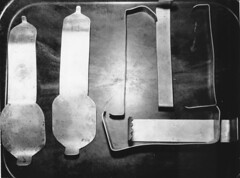
Retractors made from scrap metal. 44th Field Hospital, 8th Detachment. World War 2. 09/23/1945.
March 18:

"Gunshot fracture of left superior maxilla." Private Henry Morgan, Co. D, 77th New York Volunteers, wounded at Petersburgh, VA on April 2, 1865. Treated at Harewood Hospital, Washington DC, by Dr. Reed B. Bontecou who also had the photograph made.
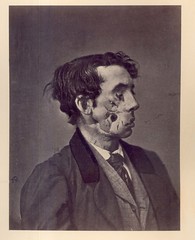
"Shell Wound of the face, with great destruction of the soft parts." Private Joseph Harvey, Co. C, 149th New York Volunteers. Wounded at Chancellorsville, Virginia on May 3 1863.
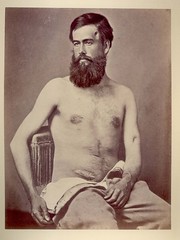
"Case of Corporal Bemis, Thrice Severely Wounded in Three Battles." Cpl. Edson D. Bemis, Co. K, 12th Massachussetts, wounded at Battles of Hatcher's Run, the Wilderness and Antietam.
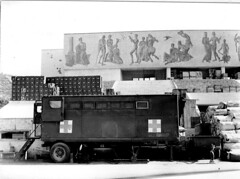
Mobile Optical Unit. 4th Medical Depot, Italy. 06/07/1944.
March 19:

Detachment of Hospital Corps taking patients over obstacles on the way to the hospital. Illustrating the equipment and operation of the brigade field hospital. Exhibit of the Army Medical Department, Pan-American Exposition, Buffalo, New York, 1901.

"Saboteuse" - World War II venereal disease prevention poster by editorial cartoonist C.D. Batchelor for the American Social Hygiene Association.
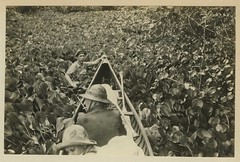
Panama. Dr. H.C. Clark. Gorgas Hospital. Ancon, Canal Zone. Club canoe forcing way through hyacinth beds, Pacora.
March 20:
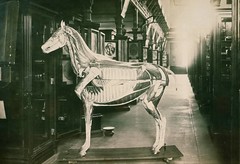
Comparative anatomy, Auzoux model of horse, life size. Specimen no. 2635. [papier mache, on display in Army Medical Museum] (We no longer have the model, although one can be seen in the Science Museum in London. This one's for Morbid Anatomy).

An enlisted technician rides along with patient to ground level to insure safety. from a series: "Air Evacuation from China to India," Patients flown over the 'hump' from China to India to be admitted to the 142nd General Hospital for further disposition.
More information about each picture can be seen on our flickr site. Visit our 3rd flickr page regularly, or sign up to be a contact so you know when new pictures go up.
March 17th:

Retractors made from scrap metal. 44th Field Hospital, 8th Detachment. World War 2. 09/23/1945.
March 18:

"Gunshot fracture of left superior maxilla." Private Henry Morgan, Co. D, 77th New York Volunteers, wounded at Petersburgh, VA on April 2, 1865. Treated at Harewood Hospital, Washington DC, by Dr. Reed B. Bontecou who also had the photograph made.

"Shell Wound of the face, with great destruction of the soft parts." Private Joseph Harvey, Co. C, 149th New York Volunteers. Wounded at Chancellorsville, Virginia on May 3 1863.

"Case of Corporal Bemis, Thrice Severely Wounded in Three Battles." Cpl. Edson D. Bemis, Co. K, 12th Massachussetts, wounded at Battles of Hatcher's Run, the Wilderness and Antietam.

Mobile Optical Unit. 4th Medical Depot, Italy. 06/07/1944.
March 19:

Detachment of Hospital Corps taking patients over obstacles on the way to the hospital. Illustrating the equipment and operation of the brigade field hospital. Exhibit of the Army Medical Department, Pan-American Exposition, Buffalo, New York, 1901.

"Saboteuse" - World War II venereal disease prevention poster by editorial cartoonist C.D. Batchelor for the American Social Hygiene Association.

Panama. Dr. H.C. Clark. Gorgas Hospital. Ancon, Canal Zone. Club canoe forcing way through hyacinth beds, Pacora.
March 20:

Comparative anatomy, Auzoux model of horse, life size. Specimen no. 2635. [papier mache, on display in Army Medical Museum] (We no longer have the model, although one can be seen in the Science Museum in London. This one's for Morbid Anatomy).

An enlisted technician rides along with patient to ground level to insure safety. from a series: "Air Evacuation from China to India," Patients flown over the 'hump' from China to India to be admitted to the 142nd General Hospital for further disposition.
More information about each picture can be seen on our flickr site. Visit our 3rd flickr page regularly, or sign up to be a contact so you know when new pictures go up.
David Challinor's obituary

I never met, nor to be honest, had heard of Dr. David Challinor of the Smithsonian before reading his obituary yesterday. These sentences caught my eye:
He also wrote more than 200 " Letters from the Desk of David Challinor" that are in the Smithsonian's digital repository and available online. They address issues such as flu pandemics, tree ecology, bird song accents and dialects, the nature of trust, hydrothermal vents and "good smells and bad."
I read the bird flu article today - it's a good summation. As you can see by downloading some of those World War 1 medical histories that have been linked to here previously, the Army Medical Museum was quite concerned with investigating the 'Spanish flu' in 1918, and specimens preserved then were used by AFIP scientists to genotype that flu in the 1990s, demonstrating one value of a museum collection. You can see the Museum's flu pictures on the main website.

And speaking of telemedicine...
...today's Washington Times had a piece on teleradiology - "Outsourcing images," by Shelley Widhalm (March 20, 2008) that talks about some of the issues, ethical and practical, involved in the practice. It's a bit of a puff piece for an area business, but gets across the points one should think about.
My earlier post on telemedicine is here.
My earlier post on telemedicine is here.
Whatever happened to... J. Carey Crane?
Another alum report - Carey was our exhibits head, but left us to go west. Carey had been the Curator of Exhibits at the Alamagordo Space Museum, but reports the "Latest twist in my checkered career: Senior Exhibits Curator for the City of Las Cruces' Museum system. Las Cruces is creating a complex including art, history, natural history museums. Several historic buildings including a railroad depot are close by."
Wednesday, March 19, 2008
What is...Street Anatomy, Alex?
For $200: A blog that that features depictions of human anatomy in various outdoor settings.
(I wonder if I would have come across something like this in any of my previous jobs...no, probably not. Cool, eh?)
Tip: Medgadget
(I wonder if I would have come across something like this in any of my previous jobs...no, probably not. Cool, eh?)
Tip: Medgadget
Identifying war dead
The anatomical collections staff of the Museum is working on an exhibit about identifying American military war dead. The New York Times ran an interesting piece about the dead of other nationalities who were buried in Thailand in mass graves when they died during World War II building the 'Death Railway' and 'the bridge over the River Kwai.'
“It is almost forgotten history,” said Sasidaran Sellappah, a retired plantation manager in Malaysia whose father was among 120 Tamil workers from a rubber estate forced to work on the railway. Only 47 survived.
“It is almost forgotten history,” said Sasidaran Sellappah, a retired plantation manager in Malaysia whose father was among 120 Tamil workers from a rubber estate forced to work on the railway. Only 47 survived.
Tuskegee syphilis study - medical history that still has repercussions
This article "Testing after Tuskegee," by Amanda Thomas, Washington Times March 19, 2008, looks at the question of if the Tuskegee syphilis studies, unethical longitudinal studies that withheld treatment for syphilitic patients when an effective one existed, keeps black participation lower in clinical trials today.
Subscribe to:
Posts (Atom)